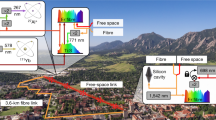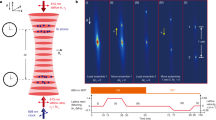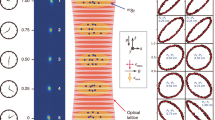Abstract
The passage of time is tracked by counting oscillations of a frequency reference, such as Earth’s revolutions or swings of a pendulum. By referencing atomic transitions, frequency (and thus time) can be measured more precisely than any other physical quantity, with the current generation of optical atomic clocks reporting fractional performance below the 10−17 level1,2,3,4,5. However, the theory of relativity prescribes that the passage of time is not absolute, but is affected by an observer’s reference frame. Consequently, clock measurements exhibit sensitivity to relative velocity, acceleration and gravity potential. Here we demonstrate local optical clock measurements that surpass the current ability to account for the gravitational distortion of space-time across the surface of Earth. In two independent ytterbium optical lattice clocks, we demonstrate unprecedented values of three fundamental benchmarks of clock performance. In units of the clock frequency, we report systematic uncertainty of 1.4 × 10−18, measurement instability of 3.2 × 10−19 and reproducibility characterized by ten blinded frequency comparisons, yielding a frequency difference of [−7 ± (5)stat ± (8)sys] × 10−19, where ‘stat’ and ‘sys’ indicate statistical and systematic uncertainty, respectively. Although sensitivity to differences in gravity potential could degrade the performance of the clocks as terrestrial standards of time, this same sensitivity can be used as a very sensitive probe of geopotential5,6,7,8,9. Near the surface of Earth, clock comparisons at the 1 × 10−18 level provide a resolution of one centimetre along the direction of gravity, so the performance of these clocks should enable geodesy beyond the state-of-the-art level. These optical clocks could further be used to explore geophysical phenomena10, detect gravitational waves11, test general relativity12 and search for dark matter13,14,15,16,17.
This is a preview of subscription content, access via your institution
Access options
Access Nature and 54 other Nature Portfolio journals
Get Nature+, our best-value online-access subscription
$29.99 / 30 days
cancel any time
Subscribe to this journal
Receive 51 print issues and online access
$199.00 per year
only $3.90 per issue
Buy this article
- Purchase on Springer Link
- Instant access to full article PDF
Prices may be subject to local taxes which are calculated during checkout




Similar content being viewed by others
Data availability
The data that support the findings of this study are available from the corresponding author upon reasonable request.
References
Chou, C. W., Hume, D. B., Koelemeij, J. C. J., Wineland, D. J. & Rosenband, T. Frequency comparison of two high-accuracy Al+ optical clocks. Phys. Rev. Lett. 104, 070802 (2010).
Nicholson, T. L. et al. Systematic evaluation of an atomic clock at 2×10−18 total uncertainty. Nat. Commun. 6, 6896 (2015).
Huntemann, N., Sanner, C., Lipphardt, B., Tamm, C. & Peik, E. Single-ion atomic clock with 3×10−18 systematic uncertainty. Phys. Rev. Lett. 116, 063001 (2016).
Schioppo, M. et al. Ultra-stable optical clock with two cold-atom ensembles. Nat. Photon. 11, 48–52 (2017).
Takano, T. et al. Geopotential measurements with synchronously linked optical lattice clocks. Nat. Photon. 10, 662–666 (2016).
Chou, C. W., Hume, D. B., Rosenband, T. & Wineland, D. J. Optical clocks and relativity. Science 329, 1630–1633 (2010).
Delva, P. & Lodewyck, J. Atomic clocks: new prospects in metrology and geodesy. Acta Futura 7, 67–78 (2013).
Lion, G. et al. Determination of a high spatial resolution geopotential model using atomic clock comparisons. J. Geod. 91, 597–611 (2017).
Grotti, J. et al. Geodesy and metrology with a transportable optical clock. Nat. Phys. 14, 437–441 (2018).
Bondarescu, R. et al. Ground-based optical atomic clocks as a tool to monitor vertical surface motion. Geophys. J. Int. 202, 1770–1774 (2015).
Kolkowitz, S. et al. Gravitational wave detection with optical lattice atomic clocks. Phys. Rev. D 94, 124043 (2016).
Delva, P. et al. Test of special relativity using a fiber network of optical clocks. Phys. Rev. Lett. 118, 221102 (2017).
Derevianko, A. & Pospelov, M. Hunting for topological dark matter with atomic clocks. Nat. Phys. 10, 933–936 (2014).
Arvanitaki, A., Huang, J. & Van Tilburg, K. Searching for dilaton dark matter with atomic clocks. Phys. Rev. D 91, 015015 (2015).
Wcisło, P. et al. Experimental constraint on dark matter detection with optical atomic clocks. Nat. Astron. 1, 0009 (2016).
Hees, A., Guéna, J., Abgrall, M., Bize, S. & Wolf, P. Searching for an oscillating massive scalar field as a dark matter candidate using atomic hyperfine frequency comparisons. Phys. Rev. Lett. 117, 061301 (2016).
Roberts, B. M. et al. Search for domain wall dark matter with atomic clocks on board global positioning system satellites. Nat. Commun. 8, 1195 (2017).
Soffel, M. et al. The IAU 2000 resolutions for astrometry, celestial mechanics, and metrology in the relativistic framework: explanatory supplement. Astron. J. 126, 2687–2706 (2003).
Vanicek, P., Castle, R. O. & Balazs, E. I. Geodetic leveling and its applications. Rev. Geophys. 18, 505–524 (1980).
Wang, Y. M., Saleh, J., Li, X. & Roman, D. R. The US Gravimetric Geoid of 2009 (USGG2009): model development and evaluation. J. Geod. 86, 165–180 (2012).
Denker, H. et al. Geodetic methods to determine the relativistic redshift at the level of 10−18 in the context of international timescales: a review and practical results. J. Geod. 92, 487–516 (2018).
Beloy, K. et al. Atomic clock with 1 × 10−18 room-temperature blackbody Stark uncertainty. Phys. Rev. Lett. 113, 260801 (2014).
Beloy, K. et al. Faraday-shielded dc Stark-shift-free optical lattice clock. Phys. Rev. Lett. 120, 183201 (2018).
Brown, R. C. et al. Hyperpolarizability and operational magic wavelength in an optical lattice clock. Phys. Rev. Lett. 119, 253001 (2017).
Ushijima, I., Takamoto, M., Das, M., Ohkubo, T. & Katori, H. Cryogenic optical lattice clocks. Nat. Photon. 9, 185–189 (2015).
Akatsuka, T., Takamoto, M. & Katori, K. Optical lattice clocks with non-interacting bosons and fermions. Nat. Phys. 4, 954–959 (2008).
Campbell, S. L. et al. A Fermi-degenerate three-dimensional optical lattice clock. Science 358, 90–94 (2017).
Gibble, K. Scattering of cold-atom coherences by hot atoms: frequency shifts from background-gas collisions. Phys. Rev. Lett. 110, 180802 (2013).
Lemke, N. D. et al. Spin-1/2 optical lattice clock. Phys. Rev. Lett. 103, 063001 (2009).
Zhang, X. et al. Spectroscopic observation of SU(N)-symmetric interactions in Sr orbital magnetism. Science 345, 1467–1473 (2014).
Pavlis, N. K. & Weiss, M. A. A re-evaluation of the relativistic redshift on frequency standards at NIST, Boulder, Colorado, USA. Metrologia 54, 535–548 (2017).
Bruinsma, S. L. et al. ESA’s satellite-only gravity field model via the direct approach based on all GOCE data. Geophys. Res. Lett. 41, 7508–7514 (2014).
Smith, D. The GRAV-D Project: Gravity for the Redefinition of the American Vertical Datum https://www.ngs.noaa.gov/GRAV-D/pubs/GRAV-D_v2007_12_19.pdf (NOAA, 2007).
Curtis, E. A., Oates, C. W. & Hollberg, L. Quenched narrow-line second- and third-stage laser cooling of 40Ca. J. Opt. Soc. Am. B 20, 977–984 (2003).
Nemitz, N. et al. Frequency ratio of Yb and Sr clocks with 5×10−17 uncertainty at 150 seconds averaging time. Nat. Photon. 10, 258–261 (2016).
Lemke, N. D. et al. p-wave cold collisions in an optical lattice clock. Phys. Rev. Lett. 107, 103902 (2011).
Julienne, P. S. & Mies, F. H. Collisions of ultracold trapped atoms. J. Opt. Soc. Am. B 6, 2257–2269 (1989).
Dzuba, V. A. & Derevianko, A. Dynamic polarizabilities and related properties of clock states of the ytterbium atom. J. Phys. B 43, 074011 (2010).
Swallows, M. D. et al. Suppression of collisional shifts in a strongly interacting lattice clock. Science 331, 1043–1046 (2011).
Katori, H., Takamoto, M., Pal’chikov, V. G. & Ovsiannikov, V. D. Ultrastable optical clock with neutral atoms in an engineered light shift trap. Phys. Rev. Lett. 91, 173005 (2003).
Ma, L., Jungner, P., Ye, J. & Hall, J. L. Delivering the same optical frequency at two places: accurate cancellation of phase noise introduced by an optical fiber or other time-varying path. Opt. Lett. 19, 1777–1779 (1994).
Falke, S., Misera, M., Sterr, U. & Lisdat, C. Delivering pulsed and phase stable light to atoms of an optical clock. Appl. Phys. B 107, 301–311 (2012).
Porsev, S. G. & Derevianko, A. Multipolar theory of blackbody radiation shift of atomic energy levels and its implications for optical lattice clocks. Phys. Rev. A 74, 020502 (2006).
Katori, H., Ovsiannikov, V. D., Marmo, S. I. & Palchikov, V. G. Strategies for reducing the light shift in atomic clocks. Phys. Rev. A 91, 052503 (2015).
Boyd, M. et al. Nuclear spin effects in optical lattice clocks. Phys. Rev. A 76, 022510 (2007).
Lodewyck, J., Zawada, M., Lorini, L., Gurov, M. & Lemonde, P. Observation and cancellation of a perturbing dc Stark shift in strontium optical lattice clocks. IEEE Trans. Ultrason. Ferroelectr. Freq. Control 59, 411–415 (2012).
Lemonde, P. & Wolf, P. Optical lattice clock with atoms confined in a shallow trap. Phys. Rev. A 72, 033409 (2005).
Lee, W. D., Shirley, J. H., Walls, F. L. & Drullinger, R. E. Systematic errors in cesium beam frequency standards introduced by digital control of the microwave excitation. Proc. IEEE Int. Freq. Control Symp. Expo. 113–117 (1995).
Hofmann-Wellenhof, B. & Moritz, H. Physical Geodesy (Springer, Vienna, 2005).
Bize, S. et al. Interrogation oscillator noise rejection in the comparison of atomic fountains. IEEE Trans. Ultrason. Ferroelectr. Freq. Control 47, 1253–1255 (2000).
Takamoto, M., Takano, T. & Katori, H. Frequency comparison of optical lattice clocks beyond the Dick limit. Nat. Photon. 5, 288–292 (2011).
Acknowledgements
We acknowledge financial support from the National Institute of Standards and Technology, the NASA Fundamental Physics programme, the Defense Advanced Research Projects Agency (DARPA) Quantum Assisted Sensing and Readout (QuASAR) programme and PECASE. R.C.B. acknowledges support from the National Research Council Research Associateship programme. A.D.L. acknowledges support from the International Space Science Institute for contributions to the Spacetime Metrology, Clocks and Relativistic Geodesy Workshop. We also thank T. Fortier and H. Leopardi for femtosecond optical frequency comb measurements, and J. Kitching and D. Hume for careful reading of this manuscript.
Reviewer information
Nature thanks K. Bongs, P. Delva and T. Ido for their contribution to the peer review of this work.
Author information
Authors and Affiliations
Contributions
W.F.M., X.Z., R.J.F., S.A.S., D.N. and A.D.L. carried out the instability and reproducibility measurements. W.F.M., X.Z., S.A.S., K.B., D.N., R.C.B., N.H., G.M., M.S., T.H.Y. and A.D.L. contributed to the evaluation of the uncertainty budget. A.D.L. supervised this work. All authors contributed to the final manuscript. Contributions to this article by workers at NIST, an agency of the US Government, are not subject to US copyright.
Corresponding author
Ethics declarations
Competing interests
The authors declare no competing interests.
Additional information
Publisher’s note: Springer Nature remains neutral with regard to jurisdictional claims in published maps and institutional affiliations.
Rights and permissions
About this article
Cite this article
McGrew, W.F., Zhang, X., Fasano, R.J. et al. Atomic clock performance enabling geodesy below the centimetre level. Nature 564, 87–90 (2018). https://doi.org/10.1038/s41586-018-0738-2
Received:
Accepted:
Published:
Issue Date:
DOI: https://doi.org/10.1038/s41586-018-0738-2
Keywords
This article is cited by
-
Collectively enhanced Ramsey readout by cavity sub- to superradiant transition
Nature Communications (2024)
-
Direct comparison of two spin-squeezed optical clock ensembles at the 10−17 level
Nature Physics (2024)
-
COMPASSO mission and its iodine clock: outline of the clock design
GPS Solutions (2024)
-
Realizing spin squeezing with Rydberg interactions in an optical clock
Nature (2023)
-
A lab-based test of the gravitational redshift with a miniature clock network
Nature Communications (2023)
Comments
By submitting a comment you agree to abide by our Terms and Community Guidelines. If you find something abusive or that does not comply with our terms or guidelines please flag it as inappropriate.



